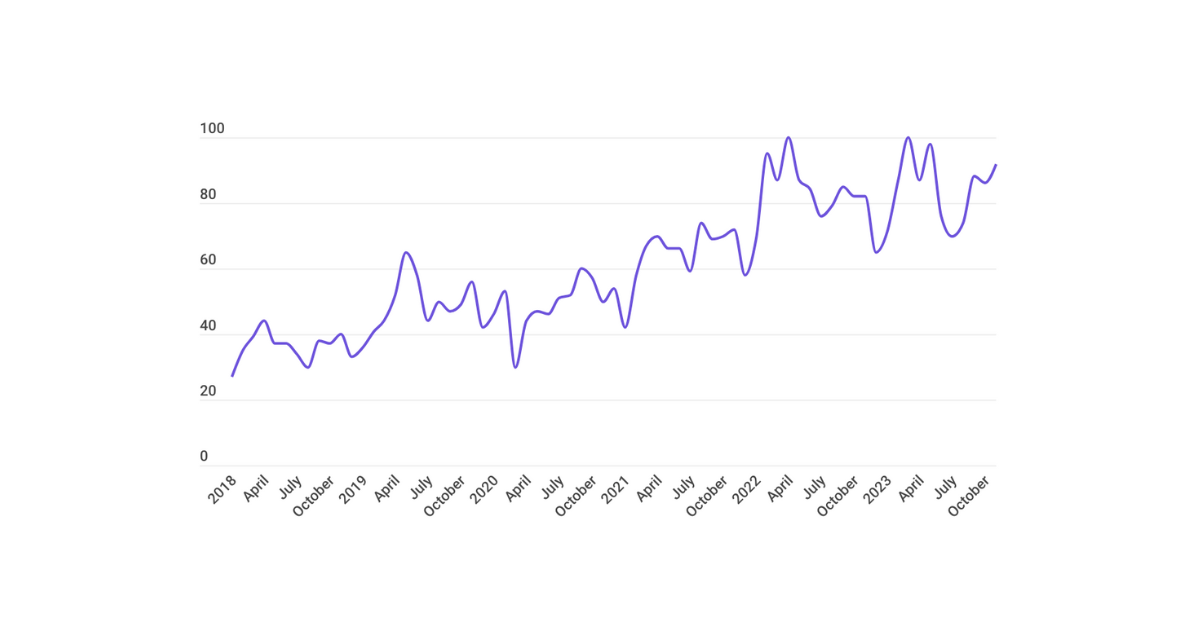Search engine optimisation (SEO) is an ever-evolving field, and to stay ahead of the competition, it’s essential to adapt to the latest trends and changes in the digital landscape. One effective strategy that can significantly impact your SEO efforts is keeping up with and leveraging current trends.
Understanding SEO and Its Importance
Before delving into the role of trends in SEO, let’s briefly review what SEO is and why it is crucial for online businesses.
Search engine optimisation (SEO) is a digital marketing practice aimed at improving a website’s visibility in search engine results. The primary goal of SEO is to increase organic (non-paid) traffic to a website by ranking higher in search engine queries, particularly on popular search engines like Google, Bing, and Yahoo.
The importance of SEO cannot be overstated. Here are a few key reasons why SEO is vital for online businesses:
Increased Visibility: SEO helps your website appear in front of a broader audience, making it more visible to potential customers.
Credibility and Trust: Websites that rank high in search results are often perceived as more trustworthy and credible by users.
Traffic and Conversions: Improved rankings lead to more organic traffic, which can translate into higher conversion rates and increased revenue.
Competitive Advantage: Staying ahead of competitors in search results can give your business a significant competitive advantage.
The Role of Trends in SEO
Trends are patterns or shifts in user behaviour, technology, and content consumption that influence how people search for information online. Leveraging these trends can positively impact your SEO strategy in several ways:
Relevance and Engagement: By staying updated with trends, you can ensure that your content remains relevant to your target audience. Addressing trending topics and industry discussions helps keep your audience engaged and interested in your content.
Market Insights and Adaptation: Monitoring trends provides valuable insights into the changing needs and preferences of your market. This information helps you adapt your messaging, products, or services to align with evolving demands, staying ahead of the competition.
Competitive Edge: Keeping an eye on industry trends allows you to stay competitive. It helps you identify what your competitors are doing and which strategies are resonating with your shared audience. This awareness enables you to adjust your content and marketing efforts effectively.
Keyword Optimisation: Trend monitoring also aids in refining your keyword strategy. Integrating trending keywords and phrases into your content enhances your website’s visibility in search results and attracts users searching for those terms.
Content Planning and Brand Authority: Staying informed about trends facilitates effective content planning. You can strategically time your content releases to coincide with peak interest in specific topics, maximizing your content’s impact. Regularly addressing trending topics also helps establish your brand as an authoritative source in your industry.
User Engagement and Social Media Strategy: Trends often gain traction on social media platforms. Staying informed about these trends allows you to refine your social media strategy, engage in relevant conversations, and expand your social reach, leading to higher user engagement.
What Type of Trends Should Marketers Monitor and Track for SEO
Marketers should monitor a variety of trends to stay relevant and effective in their strategies. Here are some key types of trends that marketers should keep an eye on:
Understanding Consumer Behaviour: To remain effective, marketers should closely monitor consumer behaviour trends. This includes tracking shifts in online shopping habits, the increasing use of mobile devices for transactions, and how social media influences consumer decision-making. Adapting strategies to align with these behaviors ensures relevance.
Content and Engagement: Marketers must keep a finger on the pulse of content consumption trends. This encompasses staying attuned to the popularity of various content formats, including video, podcasts, blogs, and infographics. Crafting content that resonates with the audience’s preferences is key to engagement.
Navigating the Evolving Social Landscape: Social media is ever-changing, making it vital for marketers to follow social media trends. This involves monitoring shifts in platform usage, content sharing dynamics, and emerging features or tools that can impact marketing strategies. Staying adaptable in the social realm is essential.
E-commerce and Product Trends: Keeping a keen eye on product trends is paramount for businesses, especially in e-commerce. This entails monitoring shifts in product preferences, emerging technologies and evolving customer expectations. The ability to align strategies with these dynamic product trends is what ensures competitiveness and market relevance for e-commerce and product led ventures.
Industry and Cultural Insights: Broad cultural and industry trends offer valuable context. Understanding shifts in values, preferences, and market dynamics helps marketers remain relevant and adaptable within their specific niche.
Competitor Analysis and Insights: Continuous competitor analysis provides insights into emerging strategies and opportunities for improvement. Analytics such as Brand Share of Search is fast becoming a key metric to understand online competitiveness but is also becoming an indicator for forecasting market share and competitor dynamics.
By staying informed about these types of trends, marketers can adapt their strategies and campaigns to meet changing consumer expectations, technology advancements, and industry dynamics, ultimately leading to more successful marketing efforts.
Trend Sources for SEO Marketers
There are various sources available for monitoring trends in marketing and related fields. Here are some valuable sources and platforms to consider:
Industry-Centric Insights:
- Industry Publications: Trade magazines, journals, and online industry-specific publications offer in-depth analysis of trends, best practices, and case studies, providing a wealth of insider knowledge.
- Market Research Reports: Reports from market research firms offer valuable data and insights, shedding light on industry trends, consumer behaviour, and market forecasts.
Social Engagement:
- Social Media Platforms: Real-time insights can be gleaned from platforms like Twitter, LinkedIn, and Instagram, offering a window into current industry trends and ‘buzzworthy’ topics.
- Social Listening Tools: Tools such as Brandwatch, Hootsuite, and Mention assist in monitoring social media conversations, brand mentions, and emerging trends.
- Content Aggregation Tools: Platforms such as Feedly and Flipboard streamline content tracking from diverse industry blogs, news sites, and influencers in one convenient location.
Expert Perspectives and Interactive Forums:
- Email Subscriptions: Subscribe to newsletters from industry experts, thought leaders, and reputable websites, delivering curated content and insights on trends straight to your inbox.
- Webinars and Online Seminars: Organisations often host webinars featuring experts discussing industry trends and best practices, providing an interactive learning experience.
- Online Communities and Forums: Engage in industry-specific forums, Reddit communities, and LinkedIn groups for discussions on current trends and challenges within your field.
Digital Tools and Analytics:
- Market Intelligence Tools: Invest in market intelligence tools like SEMrush, Moz, or SimilarWeb to access data on website traffic, keyword trends, and competitive analysis.
- Google Trends: A free tool, Google Trends enables the exploration of search term popularity over time, aiding in the identification of rising trends linked to your industry or products.


Multimedia Insights and Government Resources:
- Podcasts: Tune into industry expert podcasts for discussions on trends and insights, providing a convenient and informative way to stay updated.
- Analytics and Data Analysis: Utilize website analytics tools like Google Analytics to track user behavior and content performance, revealing trends in user engagement.
- Surveys and Customer Feedback: Gather customer feedback and conduct surveys to gain insights into emerging trends, preferences, and areas for improvement.
- Government Reports: Government agencies often publish reports related to industry statistics, economic trends, and regulatory changes impacting your business.
Elevate Trends:
We are obviously biased but Elevate Trends is our own dedicated trends platform for the health, wellness and fitness industry. The platform will dramatically reduce the time and work that you will have to put into using all of the above tools, analysing trends and developing market insight. We analyse consumer search behaviour providing you with consumer behaviour and insight in real-time. So, you can proactively act on key industry topics, emerging trends and better understand consumers attitudes towards health, wellness and fitness. Our platform will ensure you receive essential insights to shape your marketing, content and SEO strategy and stay one step ahead of your competition.


Remember that staying informed about trends is an ongoing process, and it’s important to use a combination of these sources to get a well-rounded view of what’s happening in your industry and the broader marketing landscape.
How to Create High Ranking Content Aligned with Industry Trends
Creating high-ranking content that aligns with industry trends involves a strategic approach. Here’s a step-by-step guide on how to achieve this:
Step 1 – Strategic Trend Alignment: Begin by proactively tracking the latest industry trends and emerging topics. Engage with industry-specific news sources, subscribe to newsletters, and actively participate in relevant online communities and forums to stay informed and gain insights into what’s currently shaping your field. Sign-up to our free subscription on Elevate Trends to view all the latest curated trending topics in search in our 6 core sectors of health, wellness and fitness.
Step 2 – Keyword Research and Content Gap Analysis: Conduct thorough keyword research using reputable SEO tools such as Google Keyword Planner, SEMrush, Ahrefs, or Elevate Trends. Identify trending and high-demand keywords associated with the industry trends you’ve uncovered. Simultaneously, scrutinise your competitors to identify content gaps related to these trends. Uncover topics they may have overlooked or not sufficiently covered, as this presents an opportunity for you to create valuable, differentiating content. For example, using Elevate Trends Library you can clearly see there is growing demand for people searching exercise recovery related topics. Using the trend data you can craft authoritative content by developing a topic cluster around this theme to drive users to your website who would be interested to improve their ability to recover from exercise.

Step 3 – Audience-Centric Approach: Dive deep into understanding your target audience’s interests, pain points, and questions in relation to the industry trends. Craft your content to directly address these specific needs, offering valuable insights that resonate with your audience’s preferences and expectations. Our reports in Elevate Trends provide data on top questions people type into search on a wide range of topics. Furthermore, the reports will also provide audience persona’s and segmentation to help you to develop an audience-centric approach.


Step 4 – Comprehensive and SEO-Friendly Content: Develop comprehensive content that provides in-depth coverage of the identified industry trends. Incorporate relevant data, statistics, case studies, and expert insights to make your content an authoritative resource. Prioritise on-page SEO best practices by strategically placing target keywords in titles, headings, meta descriptions, and throughout the content. Ensure your content is not only search engine-friendly but also user-friendly and mobile-responsive.
Step 5 – Quality and User Experience: Quality matters. Create content that goes beyond keywords by offering genuine value to your readers. Make your content engaging, visually appealing, and easy to navigate. Embrace multimedia elements like images, videos, and infographics where they enhance understanding and engagement.
Step 6 – Strategic Promotion and Monitoring: Promote your high-quality content across various channels, including social media, email marketing, and relevant industry forums. If you can, reach out to influencers, who align with your content’s themes, for collaboration. It’s important to continuously monitor content performance using analytics tools like Google Analytics, Google Search Console or SEMrush. We recommend tracking the basic metrics such as keyword rankings, traffic volume, and user engagement to gauge its effectiveness.
Step 7 – Adapt and Build Authority: Stay adaptive and update your content when necessary to maintain relevance and competitiveness. The more relevant and fresher the content the greater you will be percieved as an authority in your industry. Actively seek opportunities to build high-quality backlinks, leveraging outreach to industry websites, blogs, and influencers. It’s important to foster user engagement through comments and social media interactions, establishing your content as a reputable source.
Step 8 – Performance Assessment: Also, measure the success of your high-ranking content by evaluating its impact on traffic, conversions, and brand authority. Be ready to adjust your content strategy based on your findings and the evolving nature of industry trends, ensuring your content remains aligned with the dynamic landscape.
Step 9 – Measure Brand Share of Search: Brand share of search is vital measure to understand if your brand is relevant and aligned with market trends and forces. Monitoring how often your competitors’ brand names appear in search queries can indicate their brand visibility and market share. A higher brand share of search suggests stronger brand recognition and can help you gauge their competitive position. Furthermore, it provides an important measure to the success of your organic and overall marketing strategy.
By following these steps, you can create high-ranking content that not only resonates with industry trends but also delivers value to your audience and strengthens your online presence.
Trends Will Power Your SEO
Incorporating the latest trends into your SEO strategy is not just a best practice; it’s a necessity in the ever-evolving digital landscape. By staying attuned to emerging topics, industry developments, and user behaviour changes, you position your website to remain competitive, provide a better user experience, and maintain or improve search engine rankings. Whether it’s optimising for search, crafting content around trending keywords, or adapting to changing consumer preferences, embracing these trends ensures that your SEO efforts align with the dynamic nature of the online world.
Ultimately, staying current with SEO trends empowers you to connect with your target audience more effectively, drive organic traffic, and achieve long-term success in the digital realm.





